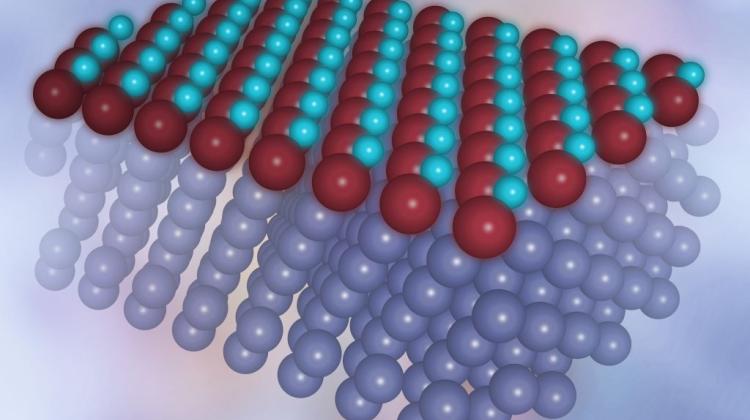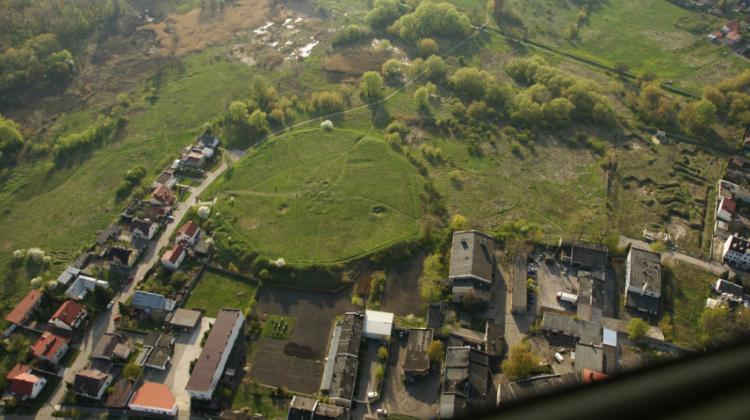Researchers created a new, surprising variety of iron oxide
 Computer visualization of a single layer of a new form of iron oxide on a platinum substrate. Iron atoms in brown, oxygen atoms in light blue. (Source: Institute of Nuclear Physics PAS)
Computer visualization of a single layer of a new form of iron oxide on a platinum substrate. Iron atoms in brown, oxygen atoms in light blue. (Source: Institute of Nuclear Physics PAS)
Scientists from Kraków created and tested a new variety of iron oxide with surprising features previously unobserved in any other material. The new oxide may be interesting for spintronics, as well as in the construction of various types of sensors and detectors.
Iron oxides occur in nature in many forms, often significantly different from each other in terms of structure and physical properties. "The new form of iron oxide (FeO) is a metallic crystal with virtually no defects, a unique conglomerate of electrical and magnetic characteristics, and atoms that vibrate as if the number of dimensions has been reduced" - reports the Institute of Nuclear Physics of the Polish Academy of Sciences in a release.
The remarkable material has been prepared, modelled and tested by physicists at the Leading National Research Centre (KNOW) in Kraków, Poland, which includes, among others, the Institute of Nuclear Physics PAS, the Institute of Catalysis and Surface Chemistry PAS and the Faculty of Physics and Applied Computer Science of AGH University of Science and Technology.
"Our new material is not an insulator, like most oxides, but metal. So this combination of electrical and magnetic properties, rare for oxides, may be interesting for spintronics, as well as in the construction of various types of sensors and detectors" - explained Dr. Przemysław Piekarz, head of Computational Materials Science at the Institute of Nuclear Physics PAS.
"We\'ve been working with modelling materials, including varieties of iron oxide, for years. Our models, constructed on the basis of the fundamental principles of quantum mechanics and statistical physics, have allowed us to determine the positions of atoms in the crystal lattice and to predict the electric, magnetic and thermodynamic properties of materials" - explained Dr. Piekarz.
The Kraków theorists specialize in studying lattice dynamics, allowing them to determine how atoms in a crystal of a material vibrate. One of the basic tools they use is the PHONON program, created and developed by Prof. Krzysztof Parliński (Institute of Nuclear Physics PAS).
"Our model contains a layer of oxygen and iron with the thickness of a single atom deposited on a substrate made of platinum. The atoms in the monolayer are arranged in a hexagonal structure, like a honeycomb" - described Dr. Piekarz. The modelled iron oxide layer turned out to be crimped: each iron atom was surrounded by three oxygen atoms, located a little further from the substrate than the iron was.
Calculations carried out for a single monolayer allowed to determine what types of vibrations were performed by atoms in the crystal lattice at different energies. The theoretical predictions were verified against the measurements thanks to a group headed by Prof. Józef Korecki (Institute of Catalysis and Surface Chemistry PAS and AGH). Not only have they developed a procedure for the preparation of samples with multiple monolayers of iron oxide on a platinum substrate, but over the past few years they have also been carrying out a series of measurements of their properties using the ESRF synchrotron in Grenoble.
Experiments at the synchrotron in Grenoble revealed that measurement data concerning vibrations of atoms in the crystal lattice of the new form of iron oxide are perfectly consistent with the theoretical model. Analysis of the results for samples with varying numbers of layers did more than just confirm the accuracy of the theoretical description.
Iron oxide usually forms crystal lattices in which atoms are arranged at the corners of a cube (this is the structure of wustite, and among other substances, table salt). It was expected that after applying successive layers of FeO such a cubic structure would automatically emerge. But analysis of vibrations of atoms in the crystal lattice of the samples showed that the systems consisting of up to around a dozen monolayers still retained the hexagonal structure. This means that the researchers from Kraków created a new variety of iron oxide, different from the existing crystal structures.
Subsequent measurements showed that for the monolayers number from six to ten, the iron atoms in the crystal have a long-range magnetic order. This is an unusual property since a basic version of iron oxide is an antiferromagnet, in which the magnetic moments of iron atoms at different locations are oriented in opposite directions, and therefore the substance as a whole is not magnetized. Meanwhile, the magnetic properties of the new form of FeO are visible even at room temperature.
"Spintronic materials for construction equipment have been sought after for many years. These instruments make use not only of the electrical current, but also the conduction of electron spin, which is responsible for its magnetic properties" - reminded Dr. Piekarz.
Of particular interest, however, was the analysis of the vibration of atoms depending on the number of FeO layers on the platinum substrate. For one or two layers, the movement of atoms is two-dimensional. When the number of layers reaches six or more, atoms vibrate as in a typical three-dimensional crystal. In previously studied materials, the nature of vibration was closely associated with the dimensionality of the system. Meanwhile, in the new variant of iron oxide at three, four and five layers, atoms vibrate in an intermediate manner, corresponding to the fractional numbers of dimensions.
"We\'re dealing with the first material in which the nature of vibration of atoms gradually passes from two-dimensional to three-dimensional. A similar effect, although expected in theory, has never before been observed in any other substance" - said Dr. Piekarz.
The group at the Institute of Nuclear Physics PAS was responsible for computer simulations of the material. The team from the Institute of Catalysis and Surface Chemistry PAS and AGH, who initiated the research, carried out experiments including the formation of new iron oxide layers and determining their properties. Physicists at the European Synchrotron Radiation Facility (ESRF) in Grenoble, the University of the Sorbonne in Paris, and the Pedagogical University of Cracow also participated in the work.
Research on a new form of iron oxide, funded by the Polish National Science Centre grants, is described in the journal Physical Review Letters.
PAP - Science and Scholarship in Poland
ekr/ agt/ zan/
tr. RL
Przed dodaniem komentarza prosimy o zapoznanie z Regulaminem forum serwisu Nauka w Polsce.


















